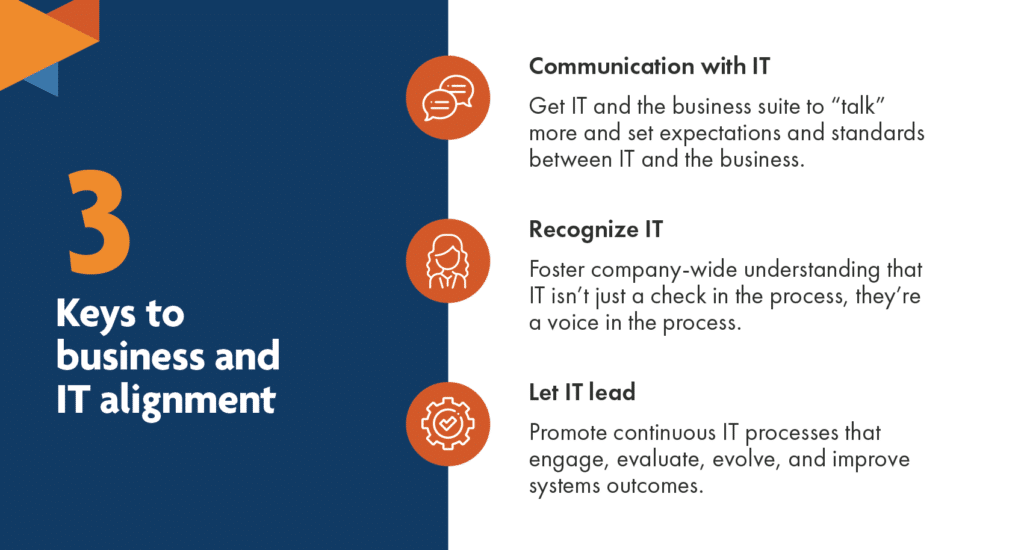Business and IT alignment are imperative for growth, efficiency, and innovation. But it’s not as straightforward as one might think. Have you ever felt like your organization has little to no business and IT alignment?
Do any of these statements sound familiar?
- “I could get my work done in half the time if I had access to more modern tools. My friends at the tech giants are all on Slack and Dropbox.” – A new college hire.
- “My team and I were asked to loop in IT during the final phases of a big software buy. Instead of helping us close out the deal, they were a total roadblock, getting hung up on service-level agreements and pointless internal busywork.” – A department leader in your organization.
Now look at it from your chief technology or information officer’s perspective:
- “I’m made out to be too tactical and in-the-weeds when it comes to upholding our company’s risk management protocol for the software we purchase. But these departments are operating in their own silos and overstepping our budget. What do you want us to do?”
If you think IT should play only a supporting, back-office role to your business teams, you might be stuck in a time, circa 1998, when your interaction with “Information Technology” was limited to someone in a Star Wars t-shirt setting up your desktop terminal.
Overcoming the divide between IT and other business units
It’s not 1998. No matter what kind of business you’re in, the technology and tools you use are no longer a back-room concern. They’re core to your survival. Looping in IT only as a final check on your business processes and purchases is no longer acceptable practice. It’s imperative that silos be removed, and IT becomes integrated and aligned with your business teams. Perhaps more importantly, your business teams need to be integrated and aligned with IT.
This was a lesson I learned repeatedly in a previous life, embedded into the procurement team of a regional property and casualty insurance carrier. It starts with these themes:

Achieving alignment between business units and IT comes down to three things:
- Communication
- Integration
- Leadership
Let’s examine each one in detail and how you can take steps in the right direction.
1. Communication is key to business and IT alignment
Like any good relationship, all parties involved need to be on the same page. As an example, in the project mentioned above, we were contracted to generate cost savings for the enterprise. However, the primary value we provided was process related. It was our job to get IT and the business suite to “talk.” This meant:
- A standardized documentation process for reviewing the service-level agreements (SLAs) and cyber security protocol of all prospective vendors
- Biweekly check-ins with the CTO and their direct reports to cover the status of all IT-adjacent projects in the pipeline
- Ensuring all software-related RFP processes had early buy-in from IT from budgetary, project ownership, security and compliance standpoints
Most important was the working relationships between IT and the various departments we covered. Setting expectations and standards between IT and the business in a non-confrontational way, before problems arose, made it easier for the business to know what IT would want.
2. IT must be recognized as a part of the business
In our experience, the single greatest point of tension between the business and IT is the cancellation of mid- to late-stage projects because of IT-driven roadblocks. While there may be a number of factors at play, it’s often related to data security or SLAs after expectations are set about going with a specific vendor.
“The result of our efforts was a greater company-wide understanding that IT isn’t just a check on the process, but rather a voice in the process.”
Abandoning invalid solutions as early as possible – and training business team members to recognize why such solutions might not meet the bar – will be mission-critical to the capacity of your business and IT teams to become properly aligned.
In this particular project, the result of our efforts was a greater company-wide understanding that IT isn’t just a check on the process, but rather a voice in the process.
3. Let IT lead
This last point cannot be emphasized enough – it’s not just about the selection and deployment. There’s more to it over time. It’s unfair, but IT can sometimes be stereotyped as “fire and forget.” In other words: too much focus on shiny new toys, not enough on dedicating resources to continuing education and management to support them effectively.

When we’ve assisted IT with software purchase processes of their own – often for software packages that would see use across the enterprise – our job goes beyond the purchase and into the exploration of the tool’s utility (particularly if it were slated to replace an existing solution).
The same was true in reverse as well.
If an individual department wants to advocate for an enterprise-wide software change, the IT team is the natural place to vet the idea. Not only will they be able to give an initial sense of available budget and remaining contractual obligations to existing vendors, but they may well lead or manage a purchase process for a similar product already on hand.
An Office Suite user who asks for a Zoom account, for example, might not know their Office 365 license includes Teams video conferencing software.
Have you achieved business and IT alignment?
When full business and IT alignment is achieved, your IT department is an asset to be leveraged, not a liability to be managed.
If you’re looking for more tactical approaches to get your IT and business units full integrated and aligned, Mod Op Strategic Consulting can help. Contact us today to learn more through a free consultation.

















